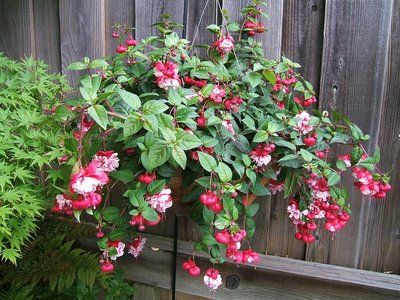I have to chuckle when I see someone admiring a basket of blooming fuchsias.
“How do they get them to bloom so much?” they say.
I tell them all you have to do is fertilize them regularly, like the growers do.
“Oh, you have to fertilize?”
Yes, plants are living things with basic requirements, just like us. Here are a few tips that can make it easy to have the lush, bountiful blooms you see in all the magazines.
Trees and shrubs
There are lots of ways to fertilize, and many kinds of fertilizer to choose from. Some plants, like established trees and shrubs, need little help from us, as long as they exhibit normal leaf size, color and desired growth. Young plants and fruit and nut trees, especially those growing in infertile soil, may grow more quickly, however, after fertilization.
Nitrogen is usually the only nutrient to which woody plants respond. Slow-release fertilizers are better, because a fertilizer that releases nutrients quickly can injure plant growth if it’s applied too heavily or incorporated into the planting hole.
A common way to destroy the microbiology of the soil is to add salts (inorganic fertilizers). The salts kill the good bacteria and fungi by dehydrating them. Then, the plant can’t feed itself and becomes dependent on its fertilizer fix. Without the good bacteria and fungi in the soil, other parts of the food chain start dying off, as well. Rapid growth from excess fertilizer can cause bark to crack, allowing fungi to enter. Too much fertilizer also promotes excessive succulent foliage, which can increase pest populations that prefer tender new growth.
Natives
As a general rule, California natives thrive in nutrient-poor soils. You probably will not need to fertilize on a regular basis, even with organic fertilizer, unless your soil is severely depleted or if the plant you are trying to grow only occurs naturally in soils with much higher fertility.
If you decide to add nutrients to the soil around natives or established trees and shrubs, the best time is when the plants are actively growing. For natives, this is late fall to spring. For other plants, late winter to late spring is best.
Choose from organic fertilizers, such as compost, chicken manure, bat guano, blood meal, cottonseed, and kelp, feather or fish meal. Organic fertilizer is also available dry in bags or as a liquid and usually contains humic acid and beneficial soil microbes. Most organic forms of nitrogen must decompose before they can be absorbed by plants and are therefore slow acting, remaining longer in the soil, where they are stored until needed by the plant.
Container plantings
What about those fuchsia baskets — what is the best way to fertilize them? Containers that are watered regularly will need to have nutrients replenished often, as they leach out with each watering. Nitrogen, especially, washes out of the soil. A nutrient-deprived plant can’t produce flowers, which is its whole purpose in life: The more flowers, the better the chance to reproduce.
Fast-acting inorganic liquid or granule fertilizers are like candy bars for a plant. Their nutrients are immediately available, which can be useful if a plant is stressed due to pest infestation or has lost leaves and vigor. Slow-release fertilizers, like Osmocote, although still inorganic, are available to the plant over a much longer time. Their nutrients are released depending on soil temperature. As our days warm, the soil does, too, right when your plants are vigorously growing.
Perennials
Perennials fall somewhere in the middle in their nutrient requirements. Drought-tolerant perennials don’t require heavy feeding. A fresh layer of compost and a light application of organic fertilizer in the spring are all that they need. Other perennials will benefit from another application or two of fertilizer, in addition to fresh compost.
As the plant absorbs nutrients through its roots, it can’t tell the difference between an organic and an inorganic fertilizer. However, organic fertilizers are less likely to burn plants, especially when it’s hot. They feed the soil and its microscopic organisms, not just the plant, and won’t contaminate the ground water.
Remember, you can kill a plant with kindness, so follow the directions on the label for whatever type of fertilizer you choose.
Jan Nelson, a landscape designer and California certified nursery professional at Plant Works in Ben Lomond, will answer questions about gardening in the Santa Cruz Mountains. E-mail her at ja******@*ol.com, or visit www.jannelsonlandscapedesign.com to view previous columns and pictures.













